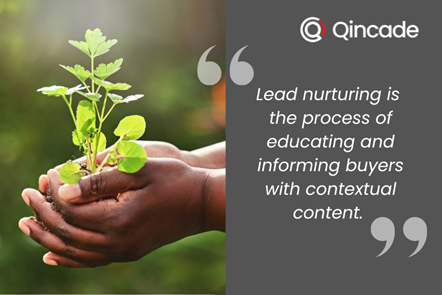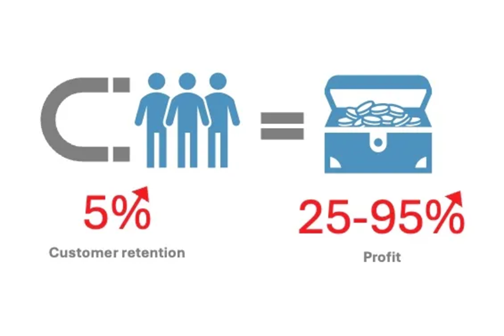How many times as a marketer coming into to a new role have you heard the phrase: “Well we have a database of 20,000 names, or 50,000 names or even 100,000 names but we don’t really do anything with them.”? Or even worse: “We don’t really engage with our customers, unless they’re either ordering from us, or have a query or complaint.”
There could be several reasons for this: maybe the information architecture of the business is such that the (Enterprise Resource Planning (ERP) and Customer Relationship Management (CRM) systems don’t talk to each other, or maybe the database isn’t well segmented, maybe the database is just an overgrown Excel file, so it’s not possible to do targeted mailings. Whatever the reason, unlocking the value held in this database is the key to your business growth.
When you think of the term nurture, don’t you get the warm fuzzies? According to the Cambridge Dictionary nurture means ‘to take care of, feed, and protect someone or something, especially young children or plants, and help him/her, or it to develop.’ When phrased like this, who wouldn’t want to be nurtured? So why when leads or customers have made the effort to engage with your business, whether it’s reading content you’ve published, taking the time to talk to you at a show, or even purchasing something from you, do you then fail to follow up with them? They’ve shown that they’re interested in what you do or what you have to say. Isn’t it therefore both discourteous and disrespectful to not engage with them in return?
To use another example. How many times would you ask a person out on a date before giving up, especially if you’re ignored or receive a negative answer? Obviously, the answer to the question is very subjective and will depend on many things, not least of all might be how attractive you find the individual in the first place. Well, the same applies to your leads and customers. No matter how attractive the offering, if they’re ignored or have a negative response or experience, they’ll eventually give up.
Customer acquisition v Customer retention
It's common knowledge that it costs more to acquire a customer than retain an existing one. Did you know that studies have shown that it can be between five and twenty-five times as much, depending on the industry and business model? In industries as specialised as Life Sciences, Biotech and MedTech, you’re more likely looking at the top end of that scale than the bottom end.
While there is an interesting discussion to be had about how one balances customer acquisition and customer retention, the focus of this blog is how to ensure that the money spent in getting leads and customers in the first place, doesn’t go to waste, and creates lasting value in a business.
Sales cycles in a lot of Life Science, MedTech and Biotech business can be extraordinarily long and complicated. In fact, in one business that we have worked with, it took on average over 800 days to move someone from the very top of the funnel to purchase. That’s over 2 years of opportunities to either engage with them further or lose their interest and therefore their business entirely.
The value you create
Let’s take a look at the key value that nurturing leads and customers can bring to a business:
1 - Improved conversion rates
- Increased engagement: By providing insightful and relevant content, you showcase thought leadership, build trust and credibility with your leads and customers and increase engagement. This makes them more likely to consider your products or services when they’re ready to make a purchase.
- Education: Scientists and healthcare professionals love to hear from their peers about the latest advancements in the field. Educating them on how your products are being used, how they solve particular problems, and their benefits helps them move down the funnel more efficiently.

2 - Enhanced relationships
- Personalisation: Being able to tailor content to your leads and customers interests and needs, makes them feel more valued and understood, enhancing your relationship with them. The more personal the content is to their situation, the higher the engagement.
- Regular engagement: Establishing a regular cadence of engagement helps ensure your brand is top-of-mind when it comes to your areas of expertise and maintains that connection with leads and customers.
3 - Increased customer lifetime value
- Upselling and cross-selling opportunities: Actively nurturing your customers provides opportunities to introduce them to other products or services that you offer, increasing the revenue from that customer and building on your average customer lifetime value.
- Loyalty and retention: When a customer is satisfied, feels valued and appreciated, they are more likely to stay loyal to your brand and remain a long-term customer, spending more along the way. While these statistics might not refer specifically to the life science sector, a recent business.com report indicates repeat customers spend on average 67% more than new customers. Even though figures can vary depending on the sector, loyal customers generally drive a substantial portion of revenue and profitability, are less price-sensitive compared to new customers and contribute to sustained revenue streams. (Deloitte)
4 - Improved customer experience
- Tailored solutions: The better your understanding of your customers’, the more able you are to provide solutions tailored to their needs, enhancing their experience of your brand and building those lasting relationships.
- Proactive engagement: Being proactive and checking-in regularly with your customers can pre-empt any issues before they escalate into major problems, increasing customer satisfaction.
5 - Higher marketing ROI
Maximising ROI: Lead nurturing ensures that all the money spent gaining leads doesn’t go to waste but focuses all efforts on converting the lead into a paying customer.

- Cost-effective: It’s generally more cost-effective to nurture the leads and customers you have than to acquire new ones. In fact, by increasing customer retention rates by 5% you can increase your profits by anything from 25% to 95% (invespcro.com).
6 - Stronger brand recognition and advocacy
- Word-of-mouth referrals: Well- nurtured leads are going to recognise your brand and have positive associations with it. This makes them more likely to advocate for your brand in the future, and as every marketer knows, word-of-mouth referrals are one of the most powerful marketing tools out there.
- Customer testimonials: Positive reviews can be a game-changer. Happy customers are far more likely to work with you on a case study or customer editorial, allowing other scientists to hear from their peers about the value your products or services bring.
7 - Better market insights
- Customer feedback: Setting time aside for gathering customer feedback pays dividends in the long term, because those insights can be used to improve and refine your offers for even greater success in your market.
- Customer journey insights: Understanding which pieces of content your leads and customers are responding to, as well as where and how they’re engaging can help refine the customer journey.
8 - Competitor advantage
- Companies in the Life Science, Biotech and MedTech sectors that focus on nurturing their leads and customers can differentiate themselves from their competitors, which is more important than ever given the competitive and highly regulated nature of these sectors. In fact, according to this Deloitte report, nurturing customers to build strong relationships can help companies navigate market volatility and regulatory changes more easily.
The ‘how’ of lead nurturing
So how can you nurture your leads to conversion, and your customers to purchase repeatedly and become brand advocates?

- Email nurturing: This involves building engagement with leads and customers through a sequence of tailored and personalised content. The main objective is to steer leads down a pathway to purchase by providing valuable information, tailored to enhance their buying decision. This is the best way to keep leads and customers engaged and re-engage those who haven’t interacted with your content for a while.
- Retargeting: Retargeting is a very effective strategy for re-engaging leads and customers on various social platforms with specific ads and social posts. Remember to make sure you match your advert with the right customer profile on the right social platform by checking in on your customer data first.
- Personalization: With the right data like professional, psychographic and behavioural data, it is possible to create personalized content relevant to your prospective customers’ interests. This is key to building a relationship with them.
- Educational content: Provide value-packed and well-researched content such as infographics, eBooks, whitepapers, webinars and case studies. This will make nurturing a positive experience and speed up their journey to conversion.
- Timely follow-ups: Be responsive. If someone asks for a quote or to speak to a salesperson, don’t leave them for days without a response. Certain lead nurturing actions can be automated in response to particular actions. For instance, if someone has filled their basket but left without transacting, you can send out an abandoned cart email after a certain amount of time has gone by. If you’ve sent a quote or proposal to a customer, following up a few days later with an email is a good way of nurturing a lead.
- Align sales and marketing: Lead conversion and customer retention rates improve when sales and marketing are working in tandem on nurturing prospective customers. Defining a strategy and process of when leads and customers should transition from one team to another and even back again, greatly enhances the customer experience. If you don’t want to involve sales too early, consider using either an Inside Sales team or even a telemarketing team to provide that one-to-one interaction that will make a lead or customer feel valued.
- Automated workflows: Setting up automated workflows to nurture leads with timely and relevant content is worth its weight in marketing gold. You can use marketing automation tools to send follow-up emails depending on the previous action, reminders and share additional content pieces around the specific customer interest or pain point. To enable this, we recommend building up a library of varied content, both in terms of format and scope that speaks to all the various challenges that you know your customers come across.
- Surveys and feedback: Running surveys and polls helps in gathering valuable insights into customer needs and preferences, and how they are changing. This gives you the opportunity to tailor communications, product offerings and services to their requirements, making them feel valued and nurtured.
Now you know the value that nurturing leads and customers can create for your business and some ways that you can approach it, there should be nothing stopping you. So, if you’re ready to take your lead nurturing to the next level, but lack the time or resources to do so, Qincade can help. Don’t let all that marketing effort and money go to waste. Value your leads, value your customers, and they’ll value your business!
What's your lead nurturing score? Take our quiz (it takes 3 minutes and it’s FREE) to get personalized score with recommendations for improvements.
